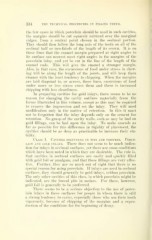Page 676 - My FlipBook
P. 676
334 THE TECHNICAL PROCEDXJRES IN FILLING TEETH.
the few cases in wMcli porcelain should be used in such cavities,
the margins should be cut squarelj" outward over the marginal
ridges, from a central point chosen in the occlusal portion.
They should then follow the long axis of the tooth on all of the
occlusal half or two-thirds of the length of its crown. It is on
these lines that the enamel margin prepared at right angles to
its surface can nearest meet right angles in the margins of the
porcelain inlay, and yet be cut in the line of the leug-th of the
enamel rods. This will give the enamel a stronger margin.
Also, in that case, the excursions of food under stress in chew-
ing will be along the lengtli of the joints, and will keep them
cleaner with the least tendency to chipping. When the margins
are laid diagonal to, or across, these lines, excursions of food
under more or less stress cross them and there is increased
chipping with less cleanliness.
In preparing cavities for gold inlays, there seems to be no
reason for changing the cavity outlines materially from the
forms illustrated in this volume, except as this may be required
to remove the impression and set the inlay. They will need
modification only in the matter of retention. In this it must
not be forgotten that the inlay depends only on the cement for
retention. No grasp of the cavity walls, such as may be had on
gold fillings, can be had upon the inlay. To make amends as
far as possible for this difference in rigidity of placement, the
cavities should be as deep as practicable to increase their sta-
bility.
Class 1. Cavities beginning in pits and pissubes. Poece-
L.\iN AND GOLD iNL.ws. Thd'c docs uot secm to be much indica-
tion for inlays in occlusal surfaces, yet there are some conditions
which have been noted in which they are desirable. The rule is,
tliat cavities in occlusal surfaces are easily and quickly filled
with gold foil or amalgam, and that these fillings are very effec-
tive. Further, they are so much out of sight that there is no
special reason for using porcelain. If inlays are used in occlusal
surfaces, they should generalh* be gold inlays, seldom porcelain.
The only other cavities of this class, in which porcelain might be
indicated, are the buccal ])its in molars. For these, however,
gold foil is generally to be preferred.
There seems to be a serious objection to the use of porce-
lain inlays in these surfaces for people in whom there is still
a strong tendency to caries, especially those who use their teeth
vigorously, because of chipping of the margins and a repro-
duction of the conditions for the beginning of decay.


